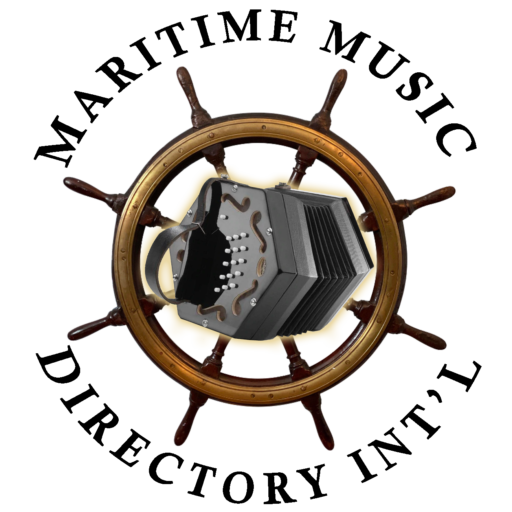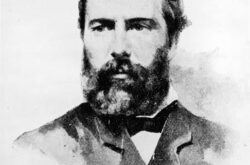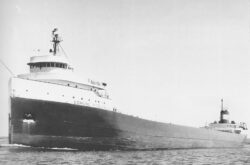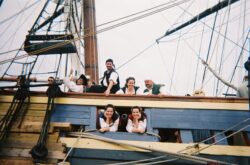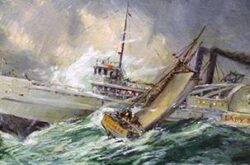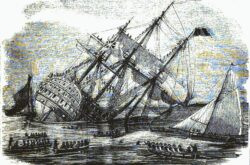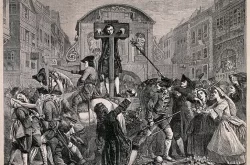Herman Melville sails for the South Seas (3 Jan 1841)
On January 3, 1841, Herman Melville ships out on the whaler Acushnet to the South Seas.
Melville was born in New York City in 1819. A childhood bout of scarlet fever permanently . . .
USS Monitor Sinks (30 Dec 1862)
On December 30, 1862, the U.S.S. Monitor sinks in a storm off Cape Hatteras, North . . .
Mayflower arrives at Plymouth Harbor (18 December 1620)
The famous Mayflower story began in 1606, when a group of reform-minded Separatists in Nottinghamshire, England, founded their own church, separate from the state-sanctioned . . .
Join a New Shanty Crew in Germany!
Here is an opportunity to join in a new shanty group with Folksinger Gunnar Wiegand!
Looking for singers for Shanty Crew
Hello everyone,
I live near Hameln . . .
Falls of Halladale Wrecks (1908)
Falls of Halladale was a four-masted iron-hulled barque, built at Greenock in Scotland in 1886 for the Falls Line of Glasgow. She was operated in the long-distance trading . . .
Cargo ship suddenly sinks in Lake Superior (1975)
On November 10, 1975, the SS Edmund Fitzgerald sinks in Lake Superior, killing all 29 crew members on board. It was the worst single accident in Lake Superior’s history.
The . . .
France officially recognises Sea Shanties as a “National Treasure”
By Tony Goodenough
London 31 Oct 2024 | France is a country that is fiercely proud of its culture and traditions. As recognition of this, the French Ministry of Culture has . . .
Bounty Sinks off Coast of North Carolina (29 Oct 2012)
This is Dean Calin; in addition to being the founder of the Maritime Music Directory International, I am also the founder, in 2003, of the maritime music vocal group, Bounding . . .
James Henry Miller aka Ewan MacColl dies
(25 January 1915 – 22 October 1989)
James Henry Miller, better known by his stage name Ewan MacColl, was a folk singer-songwriter, folk song collector, labor activist and actor. Wikipedia
You can view . . .
23 Sept 1991 Peter Bellamy Dies
Peter Franklyn Bellamy (8 September 1944 – 24 September 1991) was an English folk singer. He was a founding member of The Young Tradition and also had a long solo career, recording numerous albums . . .
Battle of Lake Erie (10 Sept 1813)
In the first unqualified defeat of a British naval squadron in history, U.S. Captain Oliver Hazard Perry leads a fleet of nine American ships to victory over a squadron . . .
Lady Elgin Sinks off Winnetka, Illinois (1860)
The loss of the side-wheel steamship Lady Elgin was one of Lake Michigan’s most tragic maritime disasters. On September 8, 1860, the ship, returning to Milwaukee from . . .
Sir Robert Dudley Dies (6 Sept 1649)
Sir Robert Dudley (7 August 1574 – 6 September 1649) was an English explorer and cartographer. In 1594, he led an expedition to the West Indies, of which he wrote an account. . . .
Bruce Macartney Jr. Dies (2019)
Bruce Jesse Macartney Jr., 70 of Midland, died Thursday morning, September 5, 2019 at the MidMichigan Regional Medical Center. He was born May 22, 1949 in Philadelphia, . . .
Royal George Sinks During Refitting 29 Aug 1782
Royal George sank on 29 August 1782 whilst anchored at Spithead off Portsmouth. The ship was intentionally rolled so maintenance could be performed on the hull, but the . . .
A 19th-century shipwreck is filled with Champagne bottles and Sweden won’t allow anyone a sip
COPENHAGEN, Denmark (AP) — No one will be allowed to fish out any of the nearly 100 bottles of 19th-century Champagne and mineral water nestled in a shipwreck off southern . . .
Louisa Jo Killen Dies 9 August 2013
Louisa Jo Killen (born Louis Killen; 10 January 1934 – 9 August 2013) was an English folk singer from Gateshead, Tyneside, who accompanied himself on the English concertina.
Killen . . .
Effingham fights Battle of Gravelines vs. the Spanish Armada (8 Aug 1588)
Five Spanish ships were lost. The galleass San Lorenzo, flagship of Don Hugo de Moncada, ran aground at Calais and was taken by Howard after murderous fighting between the . . .
Nelson Wins Battle of the Nile (1 August 1798)
On 1st August 1798, Nelson led his fleet into action against the French fleet anchored at the mouth of the Nile in Aboukir Bay, Egypt. In a fierce action, fought in the . . .
Robinson Crusoe Author Spends Final Day in Pillory (31 July 1703)
Daniel Defoe of Robinson Crusoe fame spent the last of his three days in the pillory after being convicted of seditious libel. He was surrounded at the pillory by his supporters, . . .
